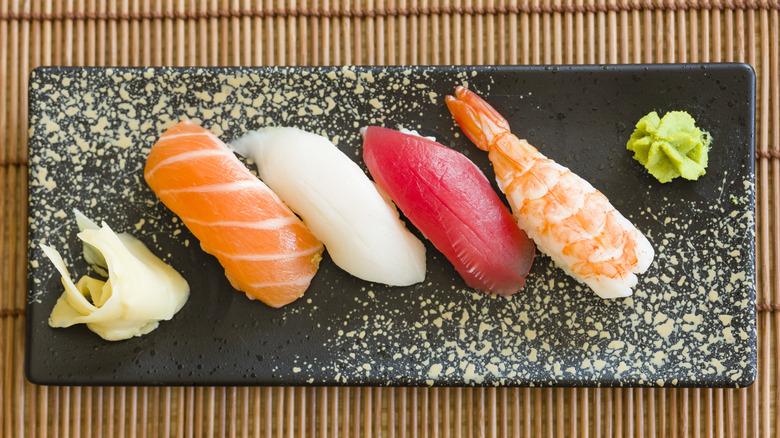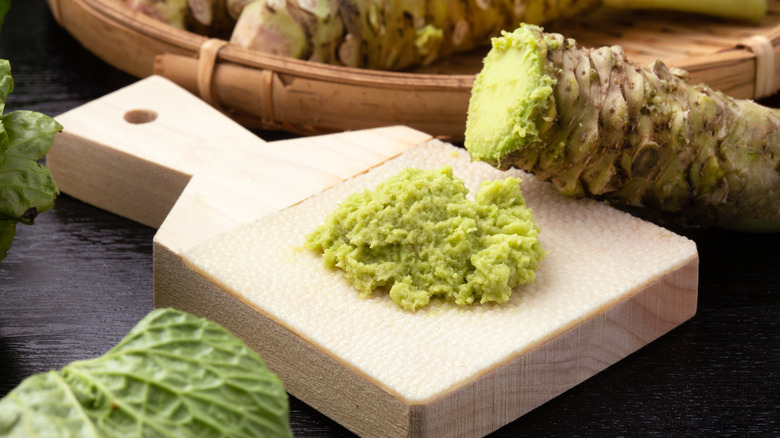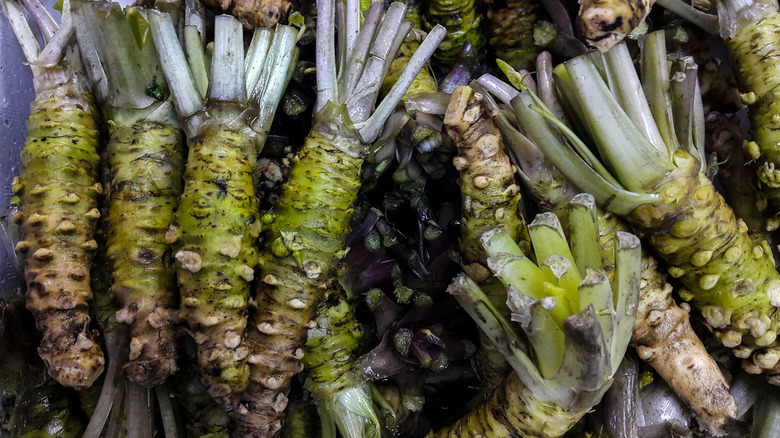The Wasabi On Your Sushi Probably Isn't Real
Most of you have eaten lots of sushi by now, which means you're familiar with the green lump of wasabi paste that always comes alongside your roll of choice. A tiny bit of the nose-clearing condiment goes a long way, but what you might not have known is that what you've been eating this whole time is probably not actually wasabi but something highly related, just in a slightly different costume.
Yep, if you've ever suspected that your restaurant wasabi is actually horseradish, you're right on the money. Wasabi is a plant that's part of the family Brassicaceae, which includes mustard and, you guessed it, horseradish. But wasabi is a picky crop. It's native to very few places, growing in South Korea, Japan, and Sakhalin in Russia, favoring mountain streams and valleys. Because it thrives under such specific conditions, it's not a plant you can easily cultivate elsewhere, though there has been limited success in other countries, including the United States. If all this wasn't specific enough, the rhizome, or edible underground stem, of wasabi can take up to three years to mature.
With the real deal being a rarity, what you're really seeing on your plate is mostly composed of rehydrated horseradish powder, mustard, and green food coloring, and there's sometimes a bit of actual wasabi powder in there for good measure. The horseradish gives the same entertainingly rapid, nasal-heavy level of spiciness that wasabi ordinarily would (which comes from a compound called allyl isothiocyanate), but horseradish is a much cheaper and more obtainable ingredient.
What is real wasabi like?
I've been fortunate enough to have had real wasabi on a few occasions, and it's worlds different from the putty-like stuff you get at most places, though I still love and enjoy the latter at home frequently. First off, the texture of fresh wasabi is akin to grated daikon radish, or, if you've never had daikon, my next closest comparison would be to finely grated red-skinned supermarket radish. It's grainy and slightly wet with quite a sharp flavor, but it's not as punishing as the reconstituted powdered kind, though it can definitely be strong.
Secondly, as soon as fresh wasabi has been grated, it starts losing its flavor, so you want to eat it immediately. If you're one of those people who likes to stir wasabi into your soy sauce, I've also noticed you can drown the real stuff's flavor out by doing so. I recommend you apply the wasabi directly to your sushi (maybe not in the same exact spot you'll be dipping your roll into soy sauce) to get the best experience out of it.
Where can you purchase real wasabi?
I'm sure plenty of you out there are looking to try fresh wasabi at least once, and thanks to modern shipping capabilities, you can certainly get your hands on some. But it'll cost you. If you don't want to venture too far, your local Japanese or general Asian supermarket might carry it in the fresh produce section.
I called the largest Japanese grocery store in my area, Mitsuwa Marketplace, and an employee told me over the phone that fresh packaged wasabi can cost anywhere between $13 to $20 per container, depending on the size of the root. It'll cost you $200 per pound if you want to purchase it in bulk.
If you want to purchase fresh wasabi online, prices can vary. One retailer, Foraged, sells 2 ounces for $29.99, while another, Real Wasabi, starts at $50 for ¼ pound of the fresh stuff. That's not including shipping charges, and since fresh wasabi root is a highly perishable item, you'll want it at your doorstep fast, which, again, will cost you.
I know not everyone's got the cash to burn on such a fleeting experience, so don't let yourself feel like you're missing out on too much if you can't try fresh wasabi. The little green ball on your plate works just as well, and in terms of heat, it's even stronger than the real thing. Plus, saving money on an expensive condiment means you can just order more sushi. At least, that's just the way I see it.


